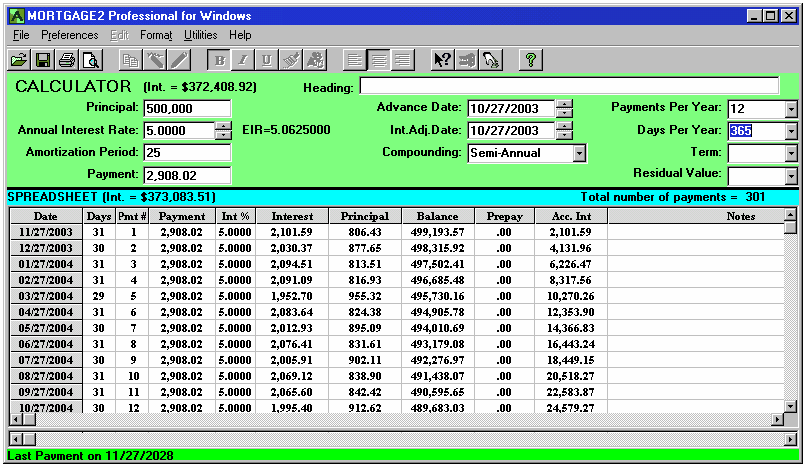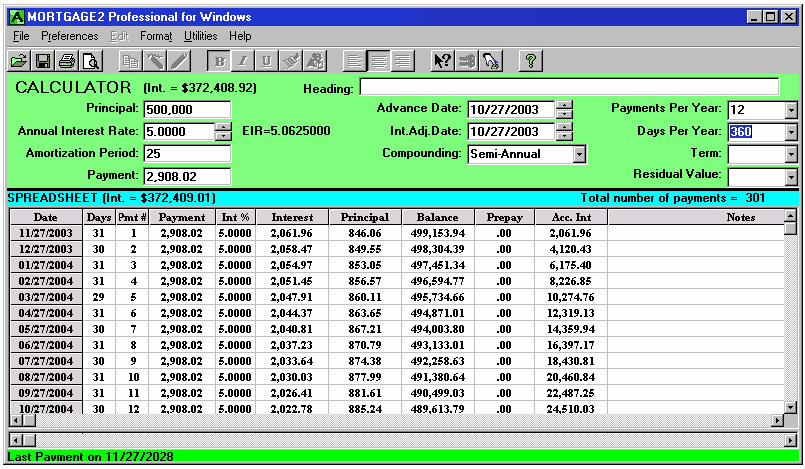National Debt Interest Savings
63 BILLION dollars in interest savings.
Canadians deserve some “thinking outside the box” regarding Federal finances. I have a “made in Canada” solution to reduce interest costs on our national debt. My solution is based on several assumptions. The critical assumption is that the loan is being paid with monthly blended payments.
Let’s assume Canada’s national debt is held by a fictitious Benevolent Bank of Canada (BBC). I will keep the numbers simple. Let’s assume the current national debt is 500 BILLION dollars (its been quoted as 507 BILLION on Oct 24th 2003) at an annual interest rate of 5% for the next 25 years with blended monthly payments. Instead of the Federal government paying monthly payments to the fictitious BBC why not pay the BBC weekly payments and minimize the current interest costs? After all, weekly payment mortgages were invented in Canada in 1984. The following example is based upon a $500,000 loan. Multiply the numbers by one million dollars (6 zeros) to arrive at the approximate national debt figures

By paying back the national debt using the minimum blended weekly payment of $669 million dollars the Canadian government would save taxpayers 2.56 BILLION dollars over 25 years. A financial calculator would confirm these numbers.
By paying back the national debt using the non accelerated weekly payments of $671 million dollars the Canadian government would save taxpayers 5 BILLION dollars over 24.86 years.
By paying back the national debt using accelerated weekly payments of $727 million dollars the Canadian government would save taxpayers almost 63 BILLION dollars over 21.41 years.
The savings look unbelievable but they are fact! The interesting figure, I call “free money”, is the 5 BILLION dollar savings for doing absolutely nothing other than paying the non accelerated weekly payment instead of the traditional monthly payments. It’s the same amount of money each year but paid back weekly instead of monthly.
Should our Federal government choose to continue with monthly payments despite the incredible interest savings achieved by weekly payments, there is another avenue that produces less substantial but significant savings nonetheless.
It must be determined if the BBC lender uses a 360 or a 365 day year schedule. A 360 day year schedule will save Canadian taxpayers 674 million dollars in interest compared to the 365 day per year schedule. Any page of an amortization schedule will make it apparent which number (360 or 365) was employed. All mathematical formulas hardwired into financial calculators are based upon a 360 day year. In fact there is no provision to input the days per year on any financial calculator. The interest factor per period is assumed to be constant because of the algebraic equations. Therefore, an amortization schedule is absolutely imperative in order to verify which type of schedule is being used.

The SPREADSHEET amortization schedule interest for the
365 day year schedule (above) is $373,083 vs $372,409 for the CALCULATOR in the 360 day year schedule (below). The difference multiplied by one million (6 zeros) is $674 million dollars.
Back to the weekly payment solution! With interest savings to taxpayers, of 63 BILLION dollars over approximately twenty one and half years, the government in Ottawa should employ this type of debt repayment strategy immediately or as soon as possible.
63 BILLION dollars can go a long way in raising the standard of living for all Canadians.

